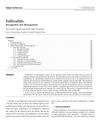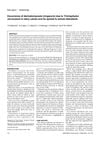Deep Facial Mycosis Due to Trichophyton Verrucosum—Molecular Genetic Identification of the Dermatophyte in Paraffin-Embedded Tissue—Case Report and Review of the Literature
October 2017
in “
Mycoses
”
TLDR An 80-year-old man's deep beard infection was cured with oral terbinafine after identifying the fungus Trichophyton verrucosum.
The article discussed a case of deep facial mycosis in an 80-year-old male patient with severe sycosis barbae, caused by the dermatophyte Trichophyton verrucosum. Despite initial treatment with systemic antibiotics, the condition did not improve. Microbial and mycological investigations identified Staphylococcus haemolyticus and Candida parapsilosis, and histology showed fungal elements in hair follicles. Molecular genetic identification was performed using DNA from paraffin-embedded tissue, confirming T. verrucosum through sequencing of the ITS2 region of rRNA. The patient achieved complete remission with oral terbinafine treatment. The study highlighted the importance of nucleic acid amplification techniques (NAAT) for the direct examination and identification of dermatophytes in clinical samples, emphasizing the effectiveness of PCR assays for detecting T. verrucosum in paraffin-embedded skin tissue.



